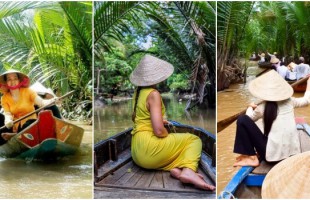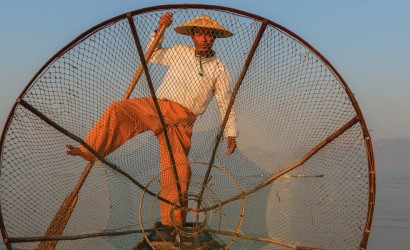Myanmar Cultural insights
Aiming to share our passion of Laos, we gather here general infomation and anecdotes for you to better understand the country's cultural, people and story.
 Our blog latest article about Myanmar
Our blog latest article about Myanmar
 Cruising the Mekong River: A Journey of Scenic Beauty and Cultural Delights
Cruising the Mekong River: A Journey of Scenic Beauty and Cultural Delights

Taking a cruise on the fascinating Mekong River offers a unique and memorable travel experience. The Mekong River, one of the longest rivers in Asia, flows through several countries, including China, Myanmar, Laos, Thailand, Cambodia, and Vietnam. Each destination along the river offers its own distinct cultural, historical, and natural attractions. In this article, we will go over what you can expect when cruising the Mekong River.
 How many days do you need in Myanmar
How many days do you need in Myanmar

How many days do you need in Myanmar
 Asia Reopening – Which countries are open for tourism and travel now?
Asia Reopening – Which countries are open for tourism and travel now?

Since the beginning of the COVID-19 pandemic, Asian countries has taken the cautious approach to inbound travel and has had some of the strictest border restrictions and closures. At the moment, the nations of the region are in the beginning stages of reopening their borders for tourism, with every country introducing its own regulations.
The “unlocking” statuses vary widely. Travelers entering Asian countries may be required to do everything from going into quarantine, submitting negative COVID-19 test results, presenting proof of health insurance, and proof of vaccination (known a vaccine passports).
There is an understandable uncertainty with how you should travel to the Asian region if you are planning to. This is why we present you the list of 19 Asian countries, along with details on the current travel situation. As each country applies precisely defined regulations, you should always check the official websites listed in the article below for the latest government announcements.
 Reopening Myanmar Tourism: What to expect?
Reopening Myanmar Tourism: What to expect?

Myanmar will resume international passenger flights from April 17, the military said on Saturday, lifting a two-year ban on foreign tourists.
 Burmese Thanaka Powder - Myanmar's Secret Beauty Ingredient
Burmese Thanaka Powder - Myanmar's Secret Beauty Ingredient

Thanaka or thanakha is a yellowish-white cosmetic paste made from ground bark. It is a distinctive feature of the culture of Myanmar, seen commonly applied to the face and sometimes the arms of women and girls, and is used to a lesser extent also by men and boys. The use of thanaka has also spread to neighboring countries including Thailand.
Within this article, we will learn everything about Thanaka and the benefits of its powder in making a secret beauty ingredient of Burmese women.
 The Story of Burmese Longyi - Myanmar’s Traditional Dress
The Story of Burmese Longyi - Myanmar’s Traditional Dress

Burmese Longyi, along with the country’s longtime history, art, and heritage sites has contributed to the richness of the local culture that will grasp your attention whenever you find yourself in strolling around the streets of Myanmar. With just a piece of fabric grasping on the lower part of the body through time, the longyi has made it become an incredible pattern of Myanmar traditional costume for both men and women. In this article, we are going to find out the secret of Myanmar quintessence through Longyi, about why it has been worn for centuries by the Burmese people.
 The colorful Kachin Manaw Festival
The colorful Kachin Manaw Festival

Kachin Manaw Festival is an annual traditional dance festival celebrated by Kachin people. Mostly held at Myitkyina, Kachin State also known as Manaw Land in Myanmar and also celebrated by Kachin people around the world. Manaw is the largest festival in Myitkyina, held at the beginning of January. Manaw Festival is the most significant event for Kachin People. Tribes of Kachin gather together in Manaw ground and dance around the erected Manaw poles. The Manau dance is performed at Manau festivals, which originated as part of the ‘Nat’ or spirit worship of the past.
 Ultimate guide for Tazaungdaing or Taunggyi Fire Balloon Festival
Ultimate guide for Tazaungdaing or Taunggyi Fire Balloon Festival

If your idea of fun involves a blurry riot of colour and explosions, look no further than the Taunngyi Fire Balloon Festival, which takes place in the culturally diverse capital of Shan State over several days every November. This celebration is held around the Full Moon of Tazaungmon, a Myanmar national holiday that marks the end of rainy season and is also known as the Tazaungdaing Festival of Lights.
Traditionally, it is a festival to pay homage to the Sulamani Pagoda by sending up decorated hot air balloons, and lately it also became as a Hot Air Balloon Competition Festival and the festival is divided into two parts; daytime competition and nighttime competition. In the daytime, hot air balloons are sent up with the shapes of various animals and mythical creatures, and hot air balloons with firework & fire-cracker (known as Nya Mee Gyi) and lot of lanterns are hanging in the hot air balloons (known as Seinnaban) are sent up in the nighttime.
 The Colorful and Magical Naga New Year Festival in Myanmar
The Colorful and Magical Naga New Year Festival in Myanmar

All year round, visitors to Myanmar can experience the country’s warm and rich culture. However, one particularly special and unique time to visit is during the Naga New Year Festival, which will be held in Lahe around mid-January every year.
This special time allows visitors the chance to experience the traditions and customs of Myanmar’s Naga people. For the Naga, Lahe (New Year) is a significant time when people share their wishes and hopes for the future, and families are reunited.
It is a time of great celebration; where lively dances are performed in traditional dress, to the beat and sounds of traditional instruments.
Few tourists are lucky enough to share in the joy and festivities of the Naga New Year, but those who do are richly rewarded with an incredible cultural experience.
Overall, for those who seek genuine cultural exchange and the opportunity to take some truly stunning photographs, the Naga New Year is an amazing and unique festival to attend.
 The Colorful & Traditional Kyaukse Elephant Dance Festival
The Colorful & Traditional Kyaukse Elephant Dance Festival

The full moon of the Thadingyut month is when Buddhists believe the Buddha descended back to earth after three months of preaching in the spiritual realm above. While the rest of Myanmar celebrates it by lighting the Buddha's way home, the town of Kyaukse near Mandalay commemorates it a little differently: with a Elephant Dance Festival, populated not by real elephants, but by pairs of dancers in gigantic elephant costumes.
Hmm... What is it? What makes it so special? and how to join the festival? You will have all the answers below.
 Epic Guide for the Golden Temple of Shwedagon Pagoda
Epic Guide for the Golden Temple of Shwedagon Pagoda

No visit to the Union of Myanmar is complete without a visit to the 2,500 years old Shwedagon Pagoda, which enshrines strands of Buddha's hair and other holy relics. Located west of the Royal Lake on 114 -acre Singuttara Hill in Yangon, Shwedagon Pagoda is the most sacred and impressive Buddhist site for the people of the Union of Myanmar. From a humble beginning of 8.2 meters, the Shwedagon Pagoda today stands close to 110 meters.
Shwedagon Pagoda is covered with hundreds of gold plates and the top of the stupa is encrusted with 4531 diamonds; the largest of which is a 72-carat diamond. It is clearly one of the wonders of the religious world. Shwedagon Pagoda is a repository of the best in Myanmar heritage – architecture, sculpture and arts. The Shwedagon Pagoda consists hundreds colorful temples, stupas, and statues that reflects the architectural era spanning almost 2,500 years.
To understand this monumental work of art and architecture, visitors will experience an insider's view of this magnificent symbol of Buddhism to the lives of the Myanmar people. Shwedagon Pagoda forms the focus of religious as well as community activities – the bustling of devotees and monks washing the statues, offering flowers, worshiping, and meditating. Shwedagon Pagoda is administered by the Board of Trustees of Shwedagon Pagoda.
 The Magical Thadingyut Festival of Light in Myanmar
The Magical Thadingyut Festival of Light in Myanmar

The Thadingyut Festival, also known as the Lighting Festival of Myanmar, is held on the full moon day of the Burmese lunar month of Thadingyut. As a custom, it is held at the end of the Buddhist sabbath (Vassa) and is the second most popular festival in Myanmar after Thingyan Festival (New Year Water Festival). Thadingyut festival is the celebration to welcome the Buddha’s descent from the heaven after he preached the Abhidhamma to his mother, Maya, who was reborn in the heaven.
Thadingyut is also one of the most magnificent lantern festival in Asia
 Top 16 Traditional Festivals in Myanmar That You Cannot Miss
Top 16 Traditional Festivals in Myanmar That You Cannot Miss

Myanmar is renowned for the Burmese people’s festive spirit, and each year, there are festivals that happen all across the country. Below is the list of festivals that you should not miss as you plan your trip to Myanmar. One thing to note is that most festivals happen according to the Burmese calendar, so the dates of the festivals may vary each year. We recommend checking the dates before you travel.
 Everything you need to know about Magha Puja (Makha Bucha)
Everything you need to know about Magha Puja (Makha Bucha)

Magha Puja (also written as Makha Bucha Day) is the third most important Buddhist festival, celebrated on the full moon day of the third lunar month in Cambodia, Laos, Thailand, Sri Lanka and on the full moon day of Tabaung in Myanmar. It celebrates a gathering that was held between the Buddha and 1,250 of his first disciples, which, according to tradition, preceded the custom of periodic recitation of discipline by monks.
On the day, Buddhists celebrate the creation of an ideal and exemplary community, which is why it is sometimes called Saṅgha Day, the Saṅgha referring to the Buddhist community, and for some Buddhist schools this is specifically the monastic community. In Thailand, the Pāli term Māgha-pūraṇamī is also used for the celebration, meaning 'to honor on the full moon of the third lunar month'.
Finally, some authors referred to the day as the Buddhist All Saints Day.
In pre-modern times, Magha Puja has been celebrated by some Southeast Asian communities. But it became widely popular in the modern period, when it was instituted in Thailand by King Rama IV in the mid-19th century. From Thailand, it spread to other South and Southeast Asian countries. Presently, it is a public holiday in some of these countries.
It is an occasion when Buddhists go to the temple to perform merit-making activities, such as alms giving, meditation and listening to teachings. It has been proposed in Thailand as a more spiritual alternative to the celebration of Valentine's Day.
 What is the meaning of Thingyan Festival – Myanmar New Year?
What is the meaning of Thingyan Festival – Myanmar New Year?

Myanmar’s answer to Thailand Songkran, Laos Boun Pimai, and Cambodia Chaul Chnam Thmey, is Thingyan Festival. It’s the annual water festival, which celebrates the coming of the new year with a nationwide display of performances, religious ceremonies and bucket loads of water. It is a sight to see and not to be missed if you are visiting the country in April.
 Complete Guide for Backpacking Myanmar
Complete Guide for Backpacking Myanmar

With its UNESCO listed Buddhist temples, friendly locals, dirt cheap prices and idiosyncratic street food, Myanmar ranks among the best destinations for a backpacker in Southeast Asia.
Much like nearby Cambodia, the country was once considered off-limits for western tourism because of its turbulent political history.
However, since 1992, when the country officially opened to the outside world, tourism has been growing with over 7.5 million international tourists set to visit the country in 2020.
Despite this, the country is much less traveled than the Southeast Asia favorites of Thailand, Cambodia, and Vietnam.
But all of this is rapidly changing. Take a quick scroll through Instagram and you will be captivated by all the beautiful images of this colorful and vibrant country.
From soaring hot air balloons over Old Bagan to the wonderfully acrobatic fishermen of the Inle Lake, it's hard to believe this undiscovered gem will stay a secret for much longer.
So if you are planning a trip to Myanmar as we enter the 2020s, what questions should you ask beforehand to ensure your trip runs smoothly?
How much money should you budget? What should you pack beforehand? How long should you spend in Myanmar? How do you pronounce Myanmar? Do the locals still call it Burma?
Even if you are the type of traveler that likes to travel without a fixed itinerary or set plans, a little research before you book your flights can make all the difference.
Here is a guide for everything you need to know about backpacking Myanmar.
Lantern Festival is celebrated in China and other Asian countries that honors deceased ancestors on the 15th day of the first month of the lunar calendar (usually falls around mid-February of Gregorian calendar). The Lantern Festival aims to promote reconciliation, peace, and forgiveness.
Originally, the holiday marks the first full moon of the new lunar year and the end of the Chinese New Year. In some other Asian countries such as Thailand or Laos, the festival is celebrated around late October or early November to mark the end of the Buddhist Lent & the beginning of the festive season.
During the festival, houses are festooned with colorful lanterns, often with riddles written on them; if the riddle is answered correctly, the solver earns a small gift. Festival celebrations also include lion and dragon dances, parades, and fireworks.
 Dragon Dances & Other New Year’s Traditions In Asia
Dragon Dances & Other New Year’s Traditions In Asia

New Year’s is not always fireworks and kisses. In Asia, it’s a time to ward off bad luck, celebrate good fortune, and commemorate family.
And since most of these countries follow the lunar or solar calendar, their festivities take place in February, March, or April, instead of on January 1st. Some cultures usher in the New Year with water gun fights, while others chase off evil spirits with demonic effigies.
Intrigued? We’ve got you covered. See how these 12 Asian countries ring in the New Year.
 To discover Myanmar
To discover Myanmar










































